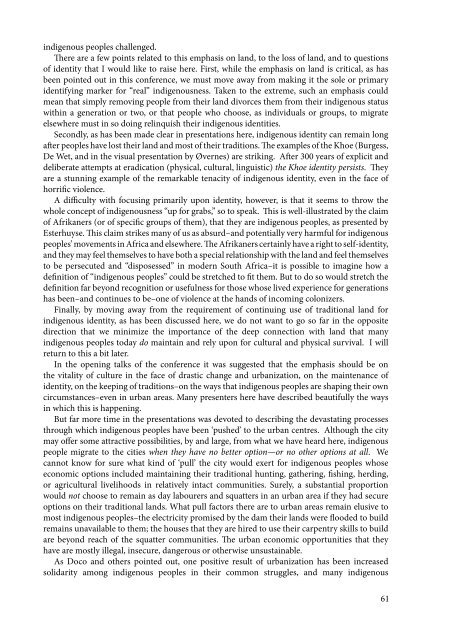Summary of Conference - Munin
Summary of Conference - Munin
Summary of Conference - Munin
Create successful ePaper yourself
Turn your PDF publications into a flip-book with our unique Google optimized e-Paper software.
indigenous peoples challenged.<br />
There are a few points related to this emphasis on land, to the loss <strong>of</strong> land, and to questions<br />
<strong>of</strong> identity that I would like to raise here. First, while the emphasis on land is critical, as has<br />
been pointed out in this conference, we must move away from making it the sole or primary<br />
identifying marker for “real” indigenousness. Taken to the extreme, such an emphasis could<br />
mean that simply removing people from their land divorces them from their indigenous status<br />
within a generation or two, or that people who choose, as individuals or groups, to migrate<br />
elsewhere must in so doing relinquish their indigenous identities.<br />
Secondly, as has been made clear in presentations here, indigenous identity can remain long<br />
after peoples have lost their land and most <strong>of</strong> their traditions. The examples <strong>of</strong> the Khoe (Burgess,<br />
De Wet, and in the visual presentation by Øvernes) are striking. After 300 years <strong>of</strong> explicit and<br />
deliberate attempts at eradication (physical, cultural, linguistic) the Khoe identity persists. They<br />
are a stunning example <strong>of</strong> the remarkable tenacity <strong>of</strong> indigenous identity, even in the face <strong>of</strong><br />
horrific violence.<br />
A difficulty with focusing primarily upon identity, however, is that it seems to throw the<br />
whole concept <strong>of</strong> indigenousness “up for grabs,” so to speak. This is well-illustrated by the claim<br />
<strong>of</strong> Afrikaners (or <strong>of</strong> specific groups <strong>of</strong> them), that they are indigenous peoples, as presented by<br />
Esterhuyse. This claim strikes many <strong>of</strong> us as absurd–and potentially very harmful for indigenous<br />
peoples’ movements in Africa and elsewhere. The Afrikaners certainly have a right to self-identity,<br />
and they may feel themselves to have both a special relationship with the land and feel themselves<br />
to be persecuted and “disposessed” in modern South Africa–it is possible to imagine how a<br />
definition <strong>of</strong> “indigenous peoples” could be stretched to fit them. But to do so would stretch the<br />
definition far beyond recognition or usefulness for those whose lived experience for generations<br />
has been–and continues to be–one <strong>of</strong> violence at the hands <strong>of</strong> incoming colonizers.<br />
Finally, by moving away from the requirement <strong>of</strong> continuing use <strong>of</strong> traditional land for<br />
indigenous identity, as has been discussed here, we do not want to go so far in the opposite<br />
direction that we minimize the importance <strong>of</strong> the deep connection with land that many<br />
indigenous peoples today do maintain and rely upon for cultural and physical survival. I will<br />
return to this a bit later.<br />
In the opening talks <strong>of</strong> the conference it was suggested that the emphasis should be on<br />
the vitality <strong>of</strong> culture in the face <strong>of</strong> drastic change and urbanization, on the maintenance <strong>of</strong><br />
identity, on the keeping <strong>of</strong> traditions–on the ways that indigenous peoples are shaping their own<br />
circumstances–even in urban areas. Many presenters here have described beautifully the ways<br />
in which this is happening.<br />
But far more time in the presentations was devoted to describing the devastating processes<br />
through which indigenous peoples have been ‘pushed’ to the urban centres. Although the city<br />
may <strong>of</strong>fer some attractive possibilities, by and large, from what we have heard here, indigenous<br />
people migrate to the cities when they have no better option—or no other options at all. We<br />
cannot know for sure what kind <strong>of</strong> ‘pull’ the city would exert for indigenous peoples whose<br />
economic options included maintaining their traditional hunting, gathering, fishing, herding,<br />
or agricultural livelihoods in relatively intact communities. Surely, a substantial proportion<br />
would not choose to remain as day labourers and squatters in an urban area if they had secure<br />
options on their traditional lands. What pull factors there are to urban areas remain elusive to<br />
most indigenous peoples–the electricity promised by the dam their lands were flooded to build<br />
remains unavailable to them; the houses that they are hired to use their carpentry skills to build<br />
are beyond reach <strong>of</strong> the squatter communities. The urban economic opportunities that they<br />
have are mostly illegal, insecure, dangerous or otherwise unsustainable.<br />
As Doco and others pointed out, one positive result <strong>of</strong> urbanization has been increased<br />
solidarity among indigenous peoples in their common struggles, and many indigenous<br />
61
















